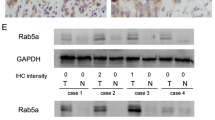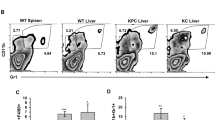Abstract
RAB27A is a member of Rab family GTPases involved in cellular vesicle trafficking, and TP53 has recently been implicated in regulating the exosome secretion pathway. Because exosome secretion plays an important role in modulating tumor microenvironment and invasive growth, we hypothesized that RAB27A and TP53 expression might be associated with aggressive behavior in pancreatic ductal adenocarcinoma (PDAC), one of the most deadly human malignancies. We determined protein expression of RAB27A and TP53 in 265 pancreatic tissues (186 carcinomas and 79 normal or benign tissues) by immunohistochemistry analysis on tissue microarray and found their expression was correlated with patients’ clinical parameters and overall survival. We found that RAB27A and TP53 protein expression was significantly higher in cancerous tissues compared to normal and benign tissues. High RAB27A protein expression (RAB27A+) was significantly associated with tumor stage and vascular invasion. No correlation between RAB27A and TP53 expression was observed. Patients with high RAB27A expression and high TP53 expression had a poor overall survival. Our data indicate that RAB27A expression is an independent prognostic marker for PDAC, and RAB27A-regulated exosome secretion pathway may represent a novel therapeutic target in pancreatic cancer .


Similar content being viewed by others
References
Jemal A, Bray F, Center MM, Ferlay J, Ward E, Forman D. Global cancer statistics. CA Cancer J Clin. 2011;61:69–90.
Bilimoria KY, Bentrem DJ, Ko CY, Ritchey J, Stewart AK, Winchester DP, Talamonti MS. Validation of the 6th edition AJCC pancreatic cancer staging system: report from the national cancer database. Cancer. 2007;110:738–44.
He XY, Yuan YZ. Advances in pancreatic cancer research: moving towards early detection. World J Gastroenterol. 2014;20:11241–8.
Bilici A. Prognostic factors related with survival in patients with pancreatic adenocarcinoma. World J Gastroenterol. 2014;20:10802–12.
Peinado H, Aleckovic M, Lavotshkin S, Matei I, Costa-Silva B, Moreno-Bueno G, Hergueta-Redondo M, Williams C, Garcia-Santos G, Ghajar C, Nitadori-Hoshino A, Hoffman C, Badal K, Garcia BA, Callahan MK, Yuan J, Martins VR, Skog J, Kaplan RN, Brady MS, Wolchok JD, Chapman PB, Kang Y, Bromberg J, Lyden D. Melanoma exosomes educate bone marrow progenitor cells toward a pro-metastatic phenotype through met. Nat Med. 2012;18:883–91.
Hoshino D, Kirkbride KC, Costello K, Clark ES, Sinha S, Grega-Larson N, Tyska MJ, Weaver AM. Exosome secretion is enhanced by invadopodia and drives invasive behavior. Cell Rep. 2013;5:1159–68.
Bhatia A, Kumar Y. Cellular and molecular mechanisms in cancer immune escape: a comprehensive review. Expert Rev Clin Immunol. 2014;10:41–62.
Bobrie A, Krumeich S, Reyal F, Recchi C, Moita LF, Seabra MC, Ostrowski M, Thery C. Rab27a supports exosome-dependent and -independent mechanisms that modify the tumor microenvironment and can promote tumor progression. Cancer Res. 2012;72:4920–30.
Chen D, Guo J, Miki T, Tachibana M, Gahl WA. Molecular cloning and characterization of rab27a and rab27b, novel human rab proteins shared by melanocytes and platelets. Biochem Mol Med. 1997;60:27–37.
Wang JS, Wang FB, Zhang QG, Shen ZZ, Shao ZM. Enhanced expression of rab27a gene by breast cancer cells promoting invasiveness and the metastasis potential by secretion of insulin-like growth factor-ii. Mol Cancer Res. 2008;6:372–82.
Li W, Hu Y, Jiang T, Han Y, Han G, Chen J, Li X. Rab27a regulates exosome secretion from lung adenocarcinoma cells a549: involvement of epi64. APMIS 2014;122:1080–87.
Ho JR, Chapeaublanc E, Kirkwood L, Nicolle R, Benhamou S, Lebret T, Allory Y, Southgate J, Radvanyi F, Goud B. Deregulation of rab and rab effector genes in bladder cancer. PLoS One. 2012;7:e39469.
Supiot S, Gouraud W, Campion L, Jezequel P, Buecher B, Charrier J, Heymann MF, Mahe MA, Rio E, Cherel M. Early dynamic transcriptomic changes during preoperative radiotherapy in patients with rectal cancer: a feasibility study. World J Gastroenterol. 2013;19:3249–54.
Webber JP, Spary LK, Sanders AJ, Chowdhury R, Jiang WG, Steadman R, Wymant J, Jones AT, Kynaston H, Mason MD, Tabi Z, Clayton A. Differentiation of tumour-promoting stromal myofibroblasts by cancer exosomes. Oncogene 2014. doi:10.1038/onc.2013.560.
Dong WW, Mou Q, Chen J, Cui JT, Li WM, Xiao WH. Differential expression of rab27a/b correlates with clinical outcome in hepatocellular carcinoma. World J Gastroenterol. 2012;18:1806–13.
Wu X, Hu A, Zhang M, Chen Z. Effects of rab27a on proliferation, invasion, and anti-apoptosis in human glioma cell. Tumour Biol. 2013;34:2195–203.
Wang H, Zhao Y, Zhang C, Li M, Jiang C, Li Y. Rab27a was identified as a prognostic biomaker by mrna profiling, correlated with malignant progression and subtype preference in gliomas. PLoS One. 2014;9:e89782.
Hollstein M, Sidransky D, Vogelstein B, Harris CC. P53 mutations in human cancers. Science. 1991;253:49–53.
Vogelstein B, Kinzler KW. P53 function and dysfunction. Cell. 1992;70:523–6.
Dutta S, Warshall C, Bandyopadhyay C, Dutta D, Chandran B. Interactions between exosomes from breast cancer cells and primary mammary epithelial cells leads to generation of reactive oxygen species which induce DNA damage response, stabilization of p53 and autophagy in epithelial cells. PLoS One. 2014;9:e97580.
Feng Z. P53 regulation of the igf-1/akt/mtor pathways and the endosomal compartment. Cold Spring Harb Perspect Biol. 2010;2:a001057.
Yu X, Riley T, Levine AJ. The regulation of the endosomal compartment by p53 the tumor suppressor gene. FEBS J. 2009;276:2201–12.
Yu X, Harris SL, Levine AK. The regulation of exosome secretion: a novel function of the p53 protein. Cancer Res. 2006;66:4795–801.
Casey G, Yamanaka Y, Friess H, Kobrin MS, Lopez ME, Buchler M, Beger HG, Korc M. P53 mutations are common in pancreatic cancer and are absent in chronic pancreatitis. Cancer Lett. 1993;69:151–60.
Cowley MJ, Chang DK, Pajic M, Johns AL, Waddell N, Grimmond SM, Biankin AV. Understanding pancreatic cancer genomes. J Hepatobiliary Pancreat Sci. 2013. doi:10.1007/s00534-013-0610-6.
Detre S, Saclani Jotti G, Dowsett M. A “Quickscore” method for immunohistochemical semiquantitation: validation for oestrogen receptor in breast carcinomas. J Clin Pathol. 1995;48:876–8.
Zhai X, Zhu H, Wang W, Zhang S, Zhang Y, Mao G. Abnormal expression of emt-related proteins, s100a4, vimentin and e-cadherin, is correlated with clinicopathological features and prognosis in hcc. Med Oncol. 2014;31:970.
Ni S, Xu L, Huang J, Feng J, Zhu H, Wang G, Wang X. Increased zo-1 expression predicts valuable prognosis in non-small cell lung cancer. Int J Clin Exp Pathol. 2013;6:2887–95.
Sun R, Wang X, Zhu H, Mei H, Wang W, Zhang S, Huang J. Prognostic value of lamp3 and tp53 overexpression in benign and malignant gastrointestinal tissues. Oncotarget 2014.
Oshima M, Okano K, Muraki S, Haba R, Maeba T, Suzuki Y, Yachida S. Immunohistochemically detected expression of 3 major genes (cdkn2a/p16, tp53, and smad4/dpc4) strongly predicts survival in patients with resectable pancreatic cancer. Ann Surg. 2013;258:336–46.
Chen J, Tang H, Wu Z, Zhou C, Jiang T, Xue Y, Huang G, Yan D, Peng Z. Overexpression of rbbp6, alone or combined with mutant tp53, is predictive of poor prognosis in colon cancer. PLoS One. 2013;8:e66524.
Arriaga JM, Bravo IA, Bruno L, Morales Bayo S, Hannois A, Sanchez Loria F, Pairola F, Huertas E, Roberti MP, Rocca YS, Aris M, Barrio MM, Baffa Trasci S, Levy EM, Mordoh J, Bianchini M. Combined metallothioneins and p53 proteins expression as a prognostic marker in patients with dukes stage b and c colorectal cancer. Hum Pathol. 2012;43:1695–703.
Mojarad S, Venturini B, Fulgenzi P, Papaleo R, Brisigotti M, Monti F, Canuti D, Ravaioli A, Woo L, Dlay S, Sherbet GV. Prediction of nodal metastasis and prognosis of breast cancer by ann-based assessment of tumour size and p53, ki-67 and steroid receptor expression. Anticancer Res. 2013;33:3925–33.
Fukuda M. Rab27 and its effectors in secretory granule exocytosis: a novel docking machinery composed of a rab27. Effector complex. Biochem Soc Trans. 2006;34:691–5.
Van Gele M, Dynoodt P, Lambert J. Griscelli syndrome: a model system to study vesicular trafficking. Pigment Cell Melanoma Res. 2009;22:268–82.
Zheng Y, Campbell EC, Lucocq J, Riches A, Powis SJ. Monitoring the rab27 associated exosome pathway using nanoparticle tracking analysis. Exp Cell Res. 2013;319:1706–13.
Lespagnol A, Duflaut D, Beekman C, Blanc L, Fiucci G, Marine JC, Vidal M, Amson R, Telerman A. Exosome secretion, including the DNA damage-induced p53-dependent secretory pathway, is severely compromised in Tsap6/steap3-null mice. Cell Death Differ. 2008;15:1723–33.
Lehmann BD, Paine MS, Brooks AM, McCubrey JA, Renegar RH, Wang R, Terrian DM. Senescence-associated exosome release from human prostate cancer cells. Cancer Res. 2008;68:7864–71.
Amzallag N, Passer BJ, Allanic D, Segura E, Thery C, Goud B, Amson R, Telerman A. Tsap6 facilitates the secretion of translationally controlled tumor protein/histamine-releasing factor via a nonclassical pathway. J Biol Chem. 2004;279:46104–12.
Acknowledgments
This study was supported by the postdoctoral study (2013-40-5) and translational medicine research (TDFzh2014011) from the Affiliated Hospital of Nantong University, Jiangsu, China.
Conflict of interest
None.
Author information
Authors and Affiliations
Corresponding authors
Rights and permissions
About this article
Cite this article
Wang, Q., Ni, Q., Wang, X. et al. High expression of RAB27A and TP53 in pancreatic cancer predicts poor survival. Med Oncol 32, 372 (2015). https://doi.org/10.1007/s12032-014-0372-2
Received:
Accepted:
Published:
DOI: https://doi.org/10.1007/s12032-014-0372-2




